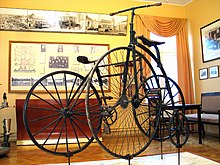Estonian Sports and Olympic Museum
 Estonian Sports Museum | |
| Established | 1963 |
|---|---|
| Location | Rüütli 15, Tartu, Estonia |
| Collection size | 135,000 (2012) |
| Director | Daimar Lell |
| Website | www |
The Estonian Sports Museum, founded in 1963 and modernised in 2001, is the largest sports museum in the Baltic states. The museum is located on Rüütli street in Tartu, Estonia and the museum has a small outpost in Otepää that concentrates on the Winter sports. The museum director is Daimar Lell.[1]
Description

The museum consists of exhibition rooms on three floors, historic cellar and specialized library. The permanent exposition "Hortus Athleticus" (in Estonian, Russian and English)[2] gives a thorough overview of the development of Estonian sport. The museum contains collections of historic awards, cups and sports equipment.
The permanent exposition is divided up into eight different parts[3] and includes a virtual Olympic tour. Estonia's first competed in the 1912 Olympic Games when the first Estonian Olympic medal, a silver,[4] was won by the middleweight wrestler Martin Klein.[5] The museum includes olympic medals and exhibits on notable Estonian athletes like Gerd Kanter, Erki Nool, Jaan Talts, Paul Keres and Georg Lurich including photographs of noted Estonian wrestlers. Visitors can test their strength on the tug-o-war and cycling simulators.[3] Visitors can also have photographs taken with famous old-time strongmen.
The museum is close to the river Emajõgi, the main building of Tartu University and the botanical gardens.[6] On the opposite side of the street is a notable secondary school (Hugo Treffner Gymnasium).
The museum hosts exhibitions from other cultures[7] and it has also created an exhibition of Estonian Olympic history in the National Library of Estonia to commemorate a century of Estonian Olympians and the opening of the 2012 Olympics in London in 2012. The museum's exhibition also celebrates that 2012 will see the first time that Estonian olympians have been to a London Olympics.[5]
Winter sports
The museum has a smaller outpost 40 km away at Otepää which is regarded as the winter sports centre of Estonia.[8]
References
- ^ "Sports Museum". spordimuuseum.ee. Retrieved 16 June 2012.
- ^ "Hortus Athleticus (English translation)". kultuuriaken.tartu.ee. Retrieved 11 June 2012.
- ^ a b "Permanent exhibition (in English)". kul.ee. Retrieved 11 June 2012.
- ^ "Martin Klein". DatabaseOlympics. Retrieved 16 June 2012.
- ^ a b "Exhibition "For the First Time in London" introduces London 2012 Games and the Estonian Olympic history". British Embassy, Tallinn. Retrieved 11 June 2012.
- ^ "Eesti Spordimuusuem". spordimuuseum.ee. Retrieved 11 June 2012.
- ^ "Exhibition of Chinese Culture, 2003". China Embassy. Retrieved 16 June 2012.
- ^ "Winter Sports". otepaa.ee. Retrieved 10 June 2012.
